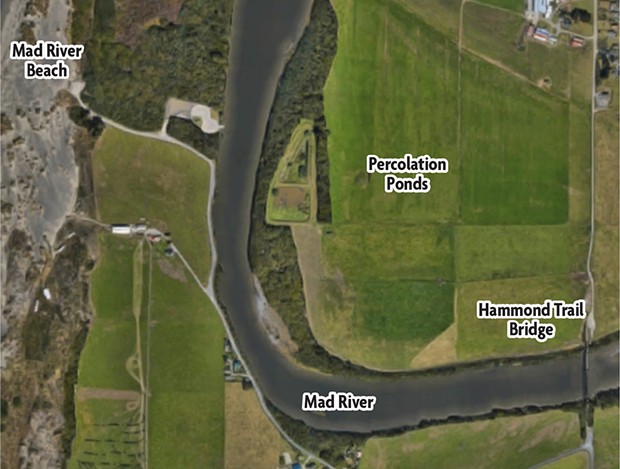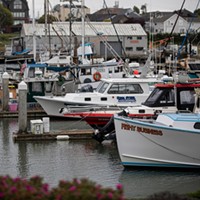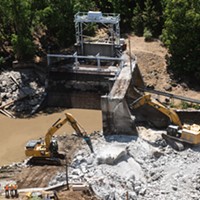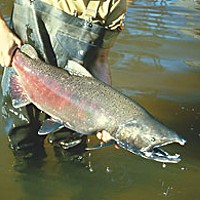[
{
"name": "Top Stories Video Pair",
"insertPoint": "7",
"component": "17087298",
"parentWrapperClass": "fdn-ads-inline-content-block",
"requiredCountToDisplay": "1"
}
]
Finding a way to deal with the wastewater produced by a town full of people is a challenge, one that's forced the McKinleyville Community Services District (MCSD) to find some creative solutions. Officials are touting the emerging solution as a win-win, a cutting-edge project that will serve the district's needs at minimal cost to ratepayers while also helping the environment.
In the winter, when the Mad River is running high, cleaned and treated wastewater can be discharged directly into the river. But in the summer, when the river is low, the MCSD must find another way of dealing with the effluent. A lot of it gets used to irrigate fodder for dairy cattle on the big Fischer Ranch south of School Road but the ranch can't use up all the water. What's left over is pumped into two percolation ponds, hidden away in the riparian forest right next to the river.
Theoretically, all the water in the percolation ponds is supposed to gradually sink into the ground and recharge the aquifer, getting purified by the soil as it descends. But there is a chance that some of the water may instead end up in the river.
Over the past 30 years, water quality regulations have grown stricter and some wastewater treatment systems that were considered perfectly adequate in the 1980s don't meet modern standards.
A few years ago, an environmental group sued the city of Healdsburg, which uses a similar system of percolation ponds adjacent to a river, for allegedly violating state water quality standards. MCSD took notice, talked to the North Coast Regional Water Quality Board and decided it needed a better system of dealing with its excess wastewater in the summer.
Meanwhile, the California Department of Fish and Wildlife (DFW) has been trying to deal with a different problem. Salmonids (a category of fish that includes but is not limited to salmon) evolved in meandering rivers with abundant backwater sloughs. In these sloughs, juvenile fish could find safe harbor and feast on the plentiful insects, gaining weight and strength for the perilous journey to the ocean. But when dams were built, straightening the river's channels and speeding up the water's flow, life got much harder for these little fellows.
There are few food sources in the main channel of the river, explained Bob Pagliuco, marine habitat resource specialist for the National Oceanic and Atmospheric Administration Restoration Center. Moreover, resisting the fast flow of water in the main channel is like being on a continuous treadmill. Too many calories get expended just to stay in one place, making it difficult for the juveniles to grow. The result — smaller, less healthy adults, with lower chances of survival and fewer offspring.
DFW was looking for riverfront property owners willing to re-create backwater ponds. McKinleyville resident Mary Burke, who was active in the environmental nonprofit CalTrout and is now on the MCSD Board of Directors, connected MCSD with DFW and a win-win solution emerged.
With the help of a grant from DFW, CalTrout is partnering with MCSD and started creating plans to re-route the district's excess wastewater to another location and re-connect the district's percolation ponds to the river. Away from the main current, the hope is that former ponds will soon be colonized by aquatic plants and insects, forming great habitat for juvenile salmonids. It won't be necessary to stock the former ponds artificially; the fish will find them on their own.
"Build it and they will come," said MCSD General Manager Greg Orsini, who is overseeing the project.
Scientists see a lot of potential in the project.
"The department is very supportive of projects that bring about recovery and restoration of riparian habitat," said DFW senior environmental scientist supervisor Gordon Leppig. "California and the North Coast have lost approximately 90 percent of our riparian habitat and we are actively working to get some back. This project advances the goals in our Wildlife Action Plan and our Coho salmon recovery plan and will be beneficial to numerous riparian-dependent fish and wildlife species."
"This is a good project," Pagliuco said. "It's good for endangered species on the Mad River: the Coho, the steelhead, the chinook ... A study found that fish grow up to six times faster when they are reared in a low-velocity environment, which increases their chances of survival and their chances of returning to breed."
The wastewater that formerly filled the ponds will now water a new plantation of trees on the Fischer Ranch. Growing trees use more water than grasslands and also help the environment by sequestering carbon dioxide.
As an added bonus, the DFW has agreed to pay for some new public access to the bluffs overlooking the Mad River.
So far, the MCSD has only had to shell out $8,500 of its ratepayers' money on the project, a small price to keep out of trouble with the regulatory authorities of the state and out of environmental groups' crosshairs.
The project is currently going through environmental review, cultural resource consultation and the permitting requirements of a half-dozen agencies. But if all goes well, the young salmonids will have a new home next summer.
Elaine Weinreb is a freelance journalist. She tries to re-pay the state of California for giving her a degree in environmental studies and planning (Sonoma State University) at a time when tuition was still affordable.
Speaking of...
Comments
Showing 1-1 of 1
more from the author
-
Trouble on the Mountain
A popular outdoor recreation area is also a makeshift shooting range, causing growing safety concerns
- Jan 11, 2024
-
Port of Entry
Harbor District begins environmental review for project to turn Humboldt Bay into a wind farm manufacturing hub
- Jul 27, 2023
- More »
Latest in News
Readers also liked…
-
Through Mark Larson's Lens
A local photographer's favorite images of 2022 in Humboldt
- Jan 5, 2023
-
'To Celebrate Our Sovereignty'
Yurok Tribe to host gathering honoring 'ultimate river warrior' on the anniversary of the U.S. Supreme Court ruling that changed everything
- Jun 8, 2023



































